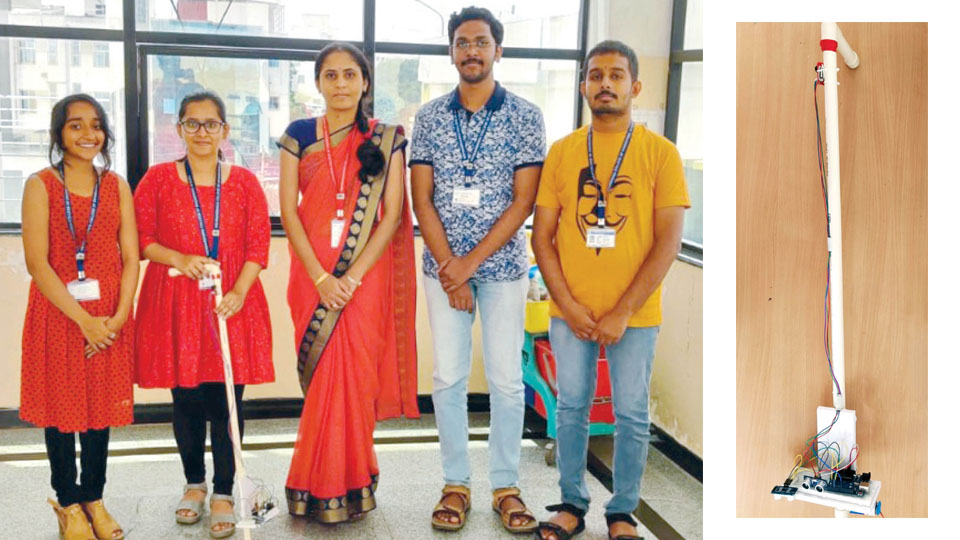Innovation at Vidyavardhaka College of Engineering is technologically better than existing smart sticks
Mysore/Mysuru: Technology can indeed neutralise human disability. Four students of Vidyavardhaka College of Engineering (VVCE), Mysuru, have developed an ultrasonic blind walking stick using Arduino that could perform more than just a stick for visually impaired persons. This smart stick has an ultrasonic sensor to sense distance from any obstacle and it can sense lighting conditions and has a remote, using which the blind man could remotely locate his smart stick.
A constant worry about potholes and obstacles has affected the confidence of visually impaired individuals when they step out of their homes. This innovative stick helps visually impaired individuals navigate swiftly, identifying potholes and obstacles while out in crowded places.
The smart stick is a low-cost, reliable, portable, consuming low power and is a robust solution to navigate with a short response time. The ultrasonic sensor is the main feature of this device and it transmits a sound pulse at a high frequency and then measures the period to obtain the sound echo signal to mirror back.
Limitations of existing smart sticks
The existing smart blind sticks have obstacle detection and pothole detection using ultrasonic sensors and digital image processing respectively leading to a problem of delay. However, this stick by VVCE students uses ultrasonic sensors for both obstacle detection and pothole detection ensuring that the alerts are timely.
Smrithi Baliga, a third-year student of Electronics and Communications Engineering, who had once been involved in scribe writing for a blind student for an exam, was intrigued by the problems faced by the blind student while crossing roads on the way to her exam venue.
Teaming up with three other classmates, H.M. Sapna, N. Shreyas, and V. Yogesh Gowda, Smrithi came up with an idea to develop a stick that helps visually impaired individuals reach their destinations safely.
IoT-based stick
The product of this team’s passion was an Internet of Things (IoT)-based stick with an obstacle and pothole detection system using ultrasonic sensors. This project was implemented under the guidance of Dr. Chandrashekar M. Patil, Professor and Head, Department of Electronics and Communications Engineering, and Assistant Professor D.L. Girijamba.
Sapna said, “During an interaction with my school teacher two years ago we discussed working on a project to help the blind. After Smrithi discussed with me her concern about the safety of the visually impaired, we eventually came up with an idea of an automated stick for them.”
Affordable and wide usage
The students realised that the stick must be affordable. “During our exploration through possible methods, we found that although image processing could be used, the cost constraints and delay in detection, we decided to deploy ultrasonic sensors for obstacle and pothole detection,” she said.
This stick has been designed not only to be cost-effective but also to be usable by people of all age groups. Smrithi Baliga said, “It is lightweight. We were determined to implement this project as our personal interest in case this was not possible in an academic setting. Fortunately, our project was approved.”
More improvisations
Shreyas, who did the coding for the automated stick said, “I have done the coding for the stick with Arduino IDE using the threshold values provided by my friends. We are planning to improvise the voice outputs of the stick. We are also planning to make the stick more accessible for people aged below 18 years by making the length of the stick adjustable for their height.”
Yogesh Gowda, who was in charge of design and implementation said, “While we were referring to research papers relating to the project, we found that the sticks that were designed earlier were heavier. We ensured that the stick that we designed should be lighter.”
Commenting on the innovation, VVCE Principal Prof. B. Sadashivegowda said, “In recent times, technology has helped in improving healthcare across the world. Through this project, our students have proven how technology could be used to help visually impaired individuals move freely with confidence.”
The team will next work on improvisations through voice output via bluetooth, upgradation of pothole detection from ultrasonic sensors to image processing techniques, Light Dependent Resistor (LDR) to sense lighting conditions and Radio Frequency (RF) remote to locate the blind stick itself.








Recent Comments